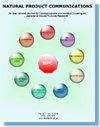Grewia bulot Gagn.叶中的化学成分及其细胞毒性活性
IF 1.4
4区 医学
Q4 CHEMISTRY, MEDICINAL
引用次数: 0
摘要
研究目的本研究的最终目的是从 Grewia bulot Gagn.叶子中分离出生物活性化合物,并评估其对人类癌细胞株的细胞毒性。方法:通过柱层析法分离化合物,并通过核磁共振光谱数据和文献对比阐明其化学结构。利用 SRB 试验评估了分离出的化合物对 MCF-7(人乳腺癌)、Hep-G2(人肝癌)、KB(人口腔癌)和 SK-LU-1(人肺癌)等 4 种癌细胞株的细胞毒性活性。研究结果从正己烷提取物中分离并鉴定出 4 种化合物,分别为蒲公英萜醇(1)、3-( E)- 香豆酰蒲公英萜醇(2)、3-( Z)- 香豆酰蒲公英萜醇(3)和羽扇豆醇(4)。此外,还从乙酸乙酯萃取物中分离出 6 种化合物,经鉴定,它们分别是 daucosterol (5)、trans-tiliroside (6)、inugalactolipid A (7)、(3 S,5 R,6 S,7 E,9 R)-7-megastigmene-3,6,9-triol (8)、biphenyl-3,3′,4,4′-tetrol (9) 和 smiglabrone B (10)。在这些分离物中,只有化合物 9 对所有测试的癌细胞株都具有中等程度的细胞毒性活性,IC50 值介于 31.67 至 63.15 µM 之间。结论联苯-3,3′,4,4′-四醇(9)有望成为开发抗癌药物的候选化合物。这项研究为人们了解具有抗癌特性的天然化合物做出了贡献。本文章由计算机程序翻译,如有差异,请以英文原文为准。
Chemical Constituents From the Leaves of Grewia bulot Gagn. and Their Cytotoxic Activity
Objective: The ultimate objective of this study was to isolate bioactive compounds from Grewia bulot Gagn. leaves and evaluate their cytotoxicity against a panel of human cancer cell lines. Methods: Compounds were isolated by column chromatography, whereas their chemical structures were elucidated by NMR spectroscopic data, and literature comparison. The cytotoxic activity of the isolated compounds was assessed using SRB assay against 4 cancer cell lines, including MCF-7 (human breast carcinoma), Hep-G2 (human hepatocellular carcinoma), KB (human carcinoma in the mouth), and SK-LU-1 (human lung carcinoma). Results: From the n-hexane extract, 4 compounds were isolated and identified as taraxerol (1), 3-( E)-coumaroyltaraxerol (2), 3-( Z)-coumaroyltaraxerol (3), and lupeol (4). Additionally, 6 compounds were isolated from the ethyl acetate extract and identified as daucosterol (5), trans-tiliroside (6), inugalactolipid A (7), (3 S,5 R,6 S,7 E,9 R)-7-megastigmene-3,6,9-triol (8), biphenyl-3,3′,4,4′-tetrol (9), and smiglabrone B (10). Among these isolates, only compound 9 exhibited moderate cytotoxic activity against all tested cancer cell lines with the IC50 values ranging from 31.67 to 63.15 µM. Conclusion: All these compounds have been detected from G bulot for the first time, biphenyl-3,3′,4,4′-tetrol (9) emerged as a promising candidate for cancer drug development. This study contributes to the growing body of knowledge regarding natural compounds with anticancer properties.
求助全文
通过发布文献求助,成功后即可免费获取论文全文。
去求助
来源期刊

Natural Product Communications
工程技术-食品科技
CiteScore
3.10
自引率
11.10%
发文量
254
审稿时长
2.7 months
期刊介绍:
Natural Product Communications is a peer reviewed, open access journal studying all aspects of natural products, including isolation, characterization, spectroscopic properties, biological activities, synthesis, structure-activity, biotransformation, biosynthesis, tissue culture and fermentation. It covers the full breadth of chemistry, biochemistry, biotechnology, pharmacology, and chemical ecology of natural products.
Natural Product Communications is a peer reviewed, open access journal studying all aspects of natural products, including isolation, characterization, spectroscopic properties, biological activities, synthesis, structure-activity, biotransformation, biosynthesis, tissue culture and fermentation. It covers the full breadth of chemistry, biochemistry, biotechnology, pharmacology, and chemical ecology of natural products.
Natural Product Communications is a peer reviewed, open access journal studying all aspects of natural products, including isolation, characterization, spectroscopic properties, biological activities, synthesis, structure-activity, biotransformation, biosynthesis, tissue culture and fermentation. It covers the full breadth of chemistry, biochemistry, biotechnology, pharmacology, and chemical ecology of natural products.
 求助内容:
求助内容: 应助结果提醒方式:
应助结果提醒方式:


